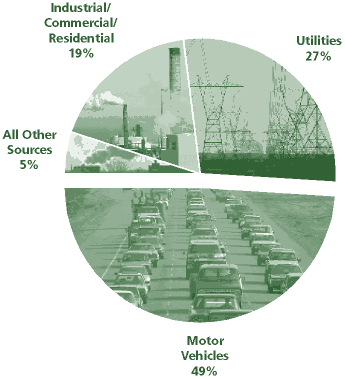|
"The Future of Energy is 'Net Zero Energy' and 'Way Beyond Solar!'"
For ad rates, send email to: advertising [ @ ] SelectiveCatalyticReduction .com
Austin, Texas marketing
[ @ ] SelectiveCatalyticReduction .com |
|
"The Future of Energy is 'Net Zero Energy' and 'Way Beyond Solar!'"
For ad rates, send email to: advertising [ @ ] SelectiveCatalyticReduction .com
Austin, Texas marketing
[ @ ] SelectiveCatalyticReduction .com |
Selective Catalytic Reduction
www.SelectiveCatalyticReduction.com
What is
Selective Catalytic
Reduction?
Selective Catalytic Reduction
(SCR) is a proven and effective method to reduce
nitrogen
oxides
which is an air pollutant associated with the power generation
process.
Nitrogen
oxides
are a contributor to ground level ozone.
How does
Selective Catalytic
Reduction work?
Selective Catalytic Reduction
Systems (SCR Systems) work similar to a catalytic converter used to reduce automobile emissions. Prior to exhaust gases going up the smokestack, they will pass through the SCR
System where anhydrous ammonia reacts with nitrogen oxide and converts it to nitrogen and water.
|
|
For ad rates, send email to:
advertising [ @ ] SelectiveCatalyticReduction .com
"Changing the Way the World Makes and Uses Energy"
Austin, Texas
marketing [ @ ] SelectiveCatalyticReduction .com
Clean Power Generation Solutions
CHP
Systems (Cogeneration
and Trigeneration)
Plants
Have Very High Efficiencies, Low Fuel Costs & Low Emissions
The Effective Heat Rate is Approximately
4100 btu/kW & System Efficiency is 92% Plant.
The CHP System
below is Rated at 900 kW and Features:
(2) Natural Gas Engines @ 450 kW each on one Skid with Optional
Selective Catalytic Reduction system that removes Nitrogen
Oxides to "non-detect."



CHP Systems may be the best solution for your company's economic and environmental sustainability as we "upgrade" natural gas to clean power with our clean power generation solutions. Emissions Abatement solutions reduce Nitrogen Oxides to "non-detect" which means our CHP Systems can be installed and operated in most EPA non-attainment regions!
What
is Clean
Combustion?
Clean Combustion includes fuels and technologies that do not require emissions abatement such as Selective Catalytic Reduction, scrubbers or other equipment needed to reduce pollution in internal combustion engines and more specifically, to reduce the hazardous air pollutants. In addition to reducing/eliminating hazardous air pollutants, the EPA is now requiring certain companies and industries to begin reducing their greenhouse gas emissions.
What is
Dry
Low NOx?
Dry Low NOx refers to handling combustion
that lowers nitrogen
oxides
during the combustion process.
Typically, a Dry Low NOx combustion systems pre-mix the air and fuel before ignition (combustion) which significantly lowers emissions.
What
are Nitrogen Oxides?
Nitrogen Oxides, or "NOx"
is the term for a group of highly reactive gases, all of which contain nitrogen
and oxygen in varying amounts. Many of the nitrogen oxides are colorless and
odorless. However, one common pollutant, nitrogen dioxide (NO2) along
with particles in the air can often be seen as a reddish-brown layer over many
urban areas.
Nitrogen Oxides
form when fuel is burned at high temperatures, as in a combustion
process. The primary sources of
Nitrogen Oxides are motor vehicles, electric utilities, and other industrial,
commercial, and residential sources that burn fuels.

are one of the main ingredients involved in the formation of ground-level ozone, which can trigger serious respiratory problems.
reacts to form nitrate particles, acid aerosols, as well as NO2, which also cause respiratory problems.
contributes to formation of acid rain.
contributes to nutrient overload that deteriorates water quality.
contributes to atmospheric particles, that cause visibility impairment most noticeable in national parks.
reacts to form toxic chemicals.
contributes to global warming.
Nitrogen oxides and the pollutants formed from NOx can be transported over long distances, following the pattern of prevailing winds in the U.S. This means that problems associated with nitrogen oxides are not confined to areas where nitrogen oxides are emitted.
Therefore, controlling nitrogen oxides is often most effective if done from a regional perspective, rather than focusing on sources in one local area.
Nitrogen Oxides emissions are increasing.
Since 1970, EPA has tracked emissions of the six principal air pollutants - carbon monoxide, lead, nitrogen oxides, particulate matter, sulfur dioxide, and volatile organic compounds. Emissions of all of these pollutants have decreased significantly except for nitrogen oxides which has increased approximately 10 percent over this period.
How
can
Nitrogen Oxides be Removed from
the Environment?
Selective Catalytic Reduction (SCR) is a proven and effective method to reduce nitrogen oxides which is an air pollutant associated with the power generation process. Nitrogen oxides are a contributor to ground level ozone.
CHP
Systems
* Clean
Combustion
* Clean
Power Generation
* Emissions
Abatement * Emissions
Engineering
Greenhouse Gas Emissions * Greenhouse Gas Reporting * Hazardous Air Pollutants * Nitrogen Oxides
OxyCombustion * Pollution Free Power * Solar Cogeneration * Trigeneration * Waste Heat Recovery
Follow us on Twitter:
#SelectiveCatalyticReduction #SCR #NOx #NitrogenOxides #NitrogenOxide

![]()

"Changing the Way the
World Makes and Uses Energy"
Selective
Catalytic Reduction
www.SelectiveCatalyticReduction.com
marketing [ @ ] SelectiveCatalyticReduction .com
SelectiveCatalyticReduction.com
Copyright ©
2003
All rights reserved